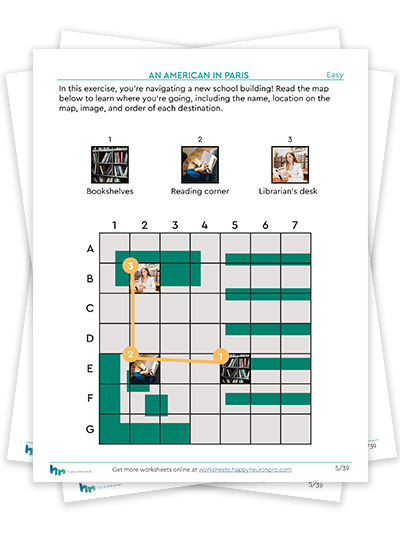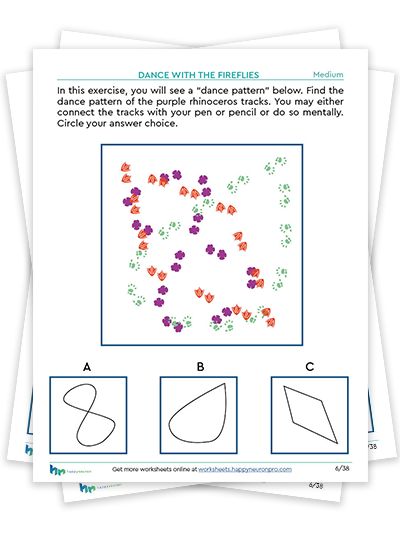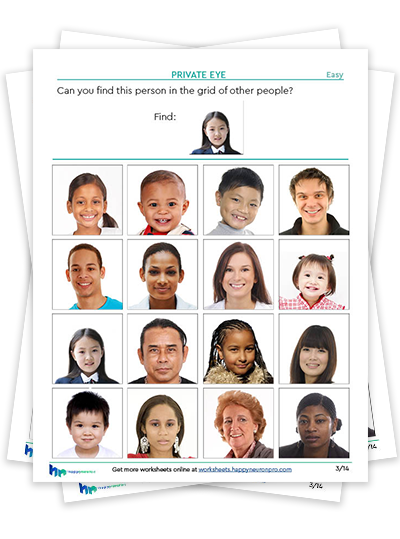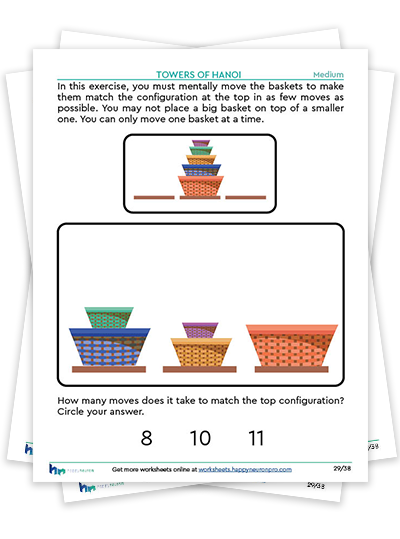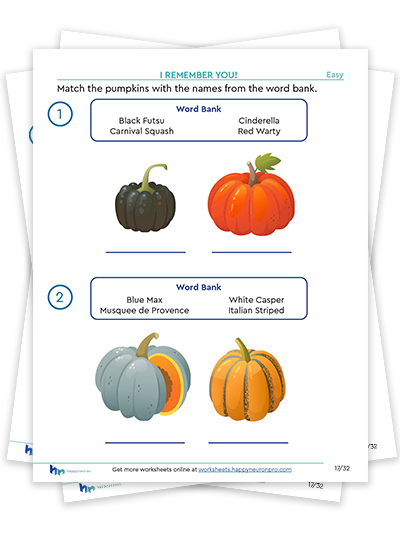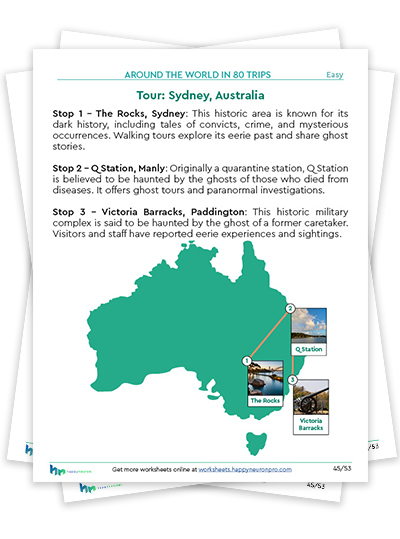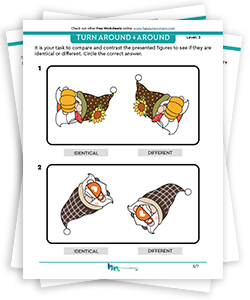Packets
Packets
Scientifically Designed Worksheets
These packets include at least 4 different exercises with each having several difficulty settings and bridging activities. Each packet focuses on a cognitive function, a medical condition, or a theme.
We release a new packet once per month and you can subscribe to get them directly in your inbox.
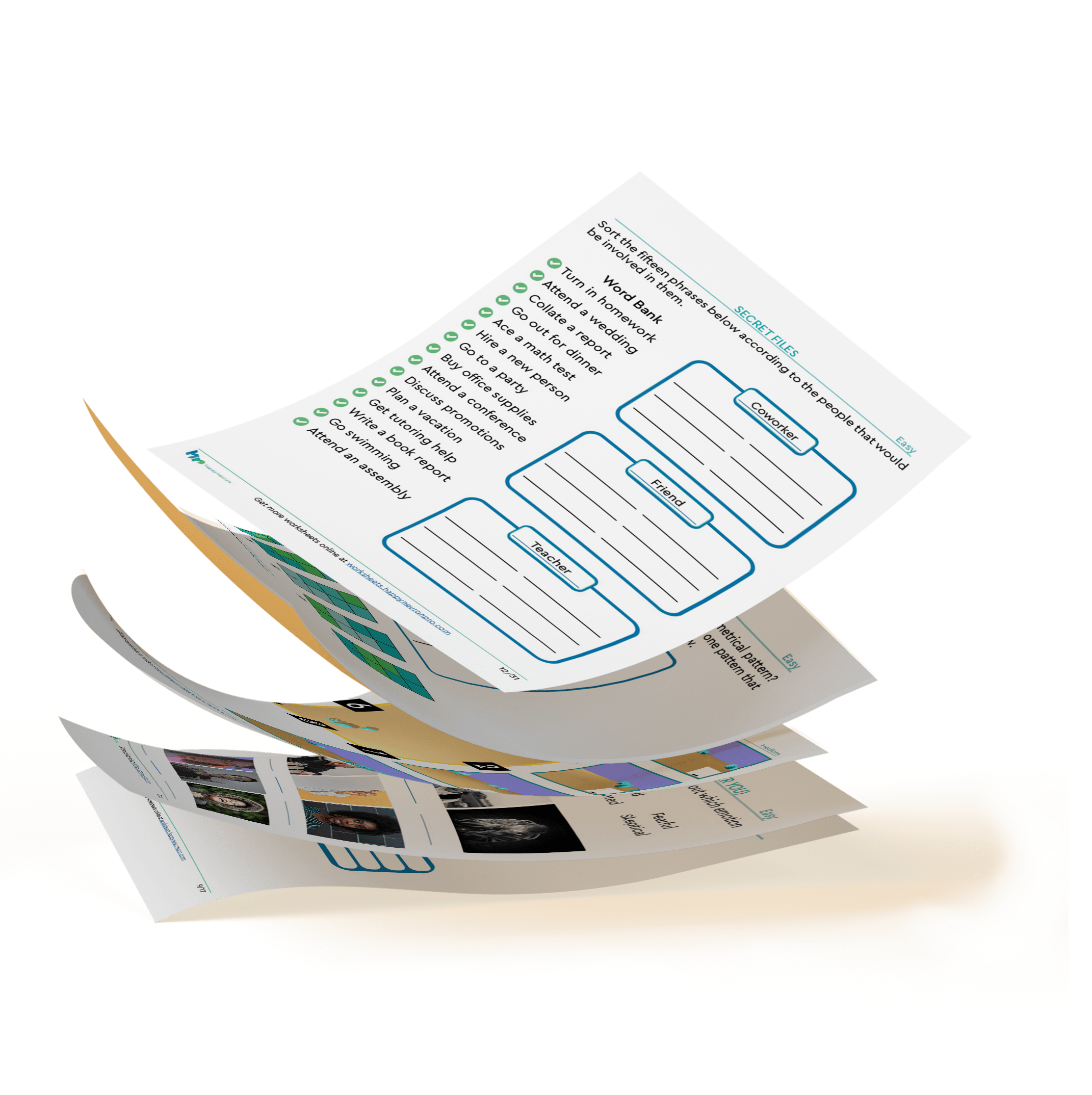
Filters
Memory
Language
Attention
Processing speed
Visual-spatial
Executive functions
Social cognition
Math and computational
Kids
Hybrid
Themed
Not purchased yet
Sort by
Get ready to work on attention skills for the new school year with this back-to-school packet! These focused attention worksheets will help you practice working memory, visual scanning, and spatial awareness skills. Based on our digital exercises, the skills practiced in these worksheets can benefit daily life. Focused attention is critical for most daily activities! Tasks like personal hygiene, reading, writing, cooking, driving, and socializing all require focused attention.
Exercises:
An American in Paris: Memorize travel itineraries by memorizing landmarks and grid locations.
Two-Timing: Complete this visual and auditory task simultaneously.
Ready, Steady, Count: Memorize numbers and operators to solve math questions.
Secret Files: Swiftly categorize words before they vanish.
This packet is great for adolescents and adults.
What’s inside: 32 focused attention worksheets, videos, and bridging questions.
Exercise your cognition — explore our full library of attention worksheets today! →
Get ready for a fun and engaging way to exercise your working memory and sustained attention with this Halloween-themed cognitive exercise packet! Perfect for those looking to work on fundamental cognitive skills, this packet is built around four exciting exercises that challenge you to stay focused and hold information in your memory. These exercises require careful focus and recall, asking users to spot differences, sort numbers, and interpret complex visual patterns. This packet is designed to help you work on sustained attention and exercise your ability to remember and work with information over short periods.
Exercises:
Displaced Characters – In this exercise, users must spot the differences between two lists of figures.
The Right Count – Sort numbers into a specific order from a randomized list as quickly as you can
Ancient Writing – Test your attention skills by identifying subtle differences between two series of symbols
Entangled Figures – Practice attention and visualization by determining which figures combine to form a larger image
This packet is great for kids, as well as individuals looking to exercise foundational cognitive skills after an injury or stroke.
What is inside: 28 attention and working memory worksheets and bridging questions.
Exercise your cognition — explore our full library of memory worksheets today! →
Embrace the beauty of plants while working on your cognitive skills with this leaf-inspired cognitive exercise packet! Perfect for individuals who want to exercise their visual attention and memory, this packet offers a variety of engaging activities designed to challenge and enhance your ability to focus and retain information. Whether you’re recovering from a brain injury or stroke, or living with mild cognitive impairment, these exercises are a fun and effective way to support cognitive health.
Exercises:
Entangled Figures – In this exercise, users are challenged to discern which figures are entangled in a larger image. This hones your ability to focus on specific details while ignoring visual noise.
I Remember You! – Based on our popular names and faces exercise, this packet puts an autumn spin on the task by asking you to memorize different types of leaves. This exercise targets both visual and verbal memory.
Shapes and Colors – Practice memorizing leafy images and selecting them from multiple options, which improves your ability to recall and recognize visual information.
Heraldry – Test your memory and concentration by remembering an image and recreating it after completing a distracting task. This exercise targets working memory and sustained attention.
This packet is great for anyone working on attention and memory skills, including after an injury or stroke, or individuals with mild cognitive impairment.
What is inside: 48 visual attention worksheets and bridging questions.
Exercise your cognition — explore our full library of attention worksheets today! →
Embark on an interstellar adventure while honing your visual-spatial skills with our space explorer-themed cognitive exercise packet! Combining a variety of engaging exercises, including a hybrid video component, this packet offers a comprehensive approach to exercising spatial memory, orientation, and navigation abilities. Whether your client is recovering from a brain injury or stroke, looking to boost spatial awareness, or simply seeking a fun and challenging mental workout, this packet provides helpful science-based exercises to help them reach their goals. Explore the cosmos and work on visual-spatial skills with the following exercises:
Objects, Where Are You?: Memorize the positions of various objects on a grid to work on spatial memory, attention to detail, and cognitive mapping.
Sleight of Hands: Determine whether a photograph depicts a left or right hand, enhancing spatial orientation and body awareness.
Under Pressure: Figure out if one object is higher or lower than another using a fun hybrid video component, exercising spatial reasoning.
Points of View: Determine your position on a map based on visual cues, working on navigation skills and spatial orientation.
What is inside: 34 visual-spatial worksheets, 3 videos, and bridging questions.
Unlock the power of memory — explore our full library of visual-spatial worksheets today! →
Dive into a world of crafts and fantasy stories, while exercising your verbal working memory and concentration skills with our thoughtfully designed cognitive exercise packet. This engaging and nostalgic packet draws inspiration from childhood joys, making the exercises not only beneficial but also reminiscent of fun times. Enjoy these verbal working memory worksheets including the following exercises:
Pay Attention: Recall numbers in a specific order to sharpen your attention and memory skills. This exercise mimics the fun of counting games and number puzzles from childhood.
Elephant Memory: Recall words presented in new contexts, enhancing your verbal memory. This exercise brings back the joy of word games and storytelling.
Private Eye: Search for a different item among a grid of matching items, practicing your scanning and concentration abilities. This activity is reminiscent of hidden object games and puzzles.
Seize the Keywords: Memorize key elements of a text and put them in order, practicing comprehension and verbal memory. This exercise takes you back to the fun of reading and summarizing stories.
This packet is perfect for seniors looking to stimulate their cognitive skills while enjoying nostalgic exercises, and anyone recovering from a brain injury or stroke who is ready for some challenging cognitive practice.
Each exercise is designed to evoke happy memories while providing a rigorous mental challenge. Whether you’re an adult looking to stay mentally fit, a senior aiming to maintain cognitive health, or a student seeking to improve academic skills, this packet offers valuable and enjoyable activities. Enhance your verbal working memory, improve your concentration, and enjoy the nostalgic journey with this delightful and effective cognitive exercise packet!
What is inside: 43 verbal working memory worksheets and bridging questions.
Unlock the power of memory —explore our full library of memory worksheets today! →
Embrace the sunny season while working on your cognitive abilities with our summer-themed cognitive exercise packet! This collection of fun executive function activities is designed to help you practice verbal and visual memory, as well as planning skills. Inspired by some of our engaging digital exercises, this packet of planning worksheets provides a comprehensive mental workout with a summer vacation twist.
The Right Count: Sharpen your arithmetic skills by ordering numbers in ascending or descending order. This activity challenges your planning abilities and helps you develop a keen sense for numerical sequences.
Embroidery: Hone your verbal memory and attention to detail by finding a hidden word within a grid of letters. This task is perfect for working on verbal recall and visual scanning skills.
Hurray for Change: Take on the dual challenge of ordering numbers and letters simultaneously. This exercise boosts your ability to multitask and enhances both numerical and alphabetical ordering skills.
An American in Paris: Work on visual and verbal memory by memorizing trips using images and location names. This activity is great for working on memory and strategy skills.
Ideal for individuals recovering from a brain injury and looking to improve daily cognitive functions, seniors who want to engage in stimulating activities, or students looking to exercise critical thinking, memory retention, and organizational skills.
What is inside: 41 unique planning worksheets and bridging questions.
Unlock the power of executive functions —explore our full library of executive function worksheets today! →
Explore a town like never before with these engaging spatial memory worksheets, turning a bike ride into an exciting cognitive adventure! This comprehensive packet is inspired by four of our popular digital exercises, each crafted to enhance specific cognitive skills.
Start with “Catch the Ladybug,” a delightful activity that works on visual attention and spatial awareness as you spot various items on the page. Then, move on to “Dance with the Fireflies,” where you’ll hone your attention and spatial reasoning by following mesmerizing tangled patterns.
Challenge your mind further with “Turn Around and Around,” an exercise that sharpens your mental imagery and rotation abilities. Visualize objects from different angles and improve your ability to manipulate them in your mind’s eye. Finally, navigate through “Find Your Way,” a task that focuses on strengthening your spatial memory as you memorize and recall intricate pathways.
This packet is meticulously designed to exercise a range of cognitive skills, including attention, spatial reasoning, memory, and planning. Whether you’re an adult or senior looking to keep your mind sharp, or an adolescent seeking a challenge, these exercises offer an enjoyable and cognitively stimulating experience.
What is inside: 38 unique attention and spatial memory worksheets and bridging questions.
Unlock the power of spatial skills —explore our full library of visual-spatial worksheets today! →
Set your students on an exciting animal-tracking adventure with our specially crafted focus attention activity packet! In this engaging journey, students will immerse themselves in a series of tasks designed to enhance their focus and attention skills.
Attention-Captivating Tasks:
The adventure begins as students decipher the intricate patterns animals leave in a field of tracks. With keen observation, they’ll identify the odd pawprint in a displaced character activity and the dance with fireflies, challenging their attention to detail. Next, spatial memory takes the spotlight as they recall the precise locations of each animal on the grid. The journey concludes with a test of divided attention skills – listening to words and categorizing animals on the screen demands concentration and focus.
Versatile for All Ages:
This attention activity packet is not just limited to a specific age group; it’s suitable for students of all ages! Animal enthusiasts will find joy in honing their focused attention skills, and teachers can seamlessly integrate these activities to help students refocus after outdoor play or any energizing activity.
Included inside 38 Unique, focused activities, 3 videos for divided attention, and bridging questions.
If the animal tracking adventure captivates your students’ attention, explore our library of attention activities for more engaging challenges. Elevate focus and cognitive skills with our diverse collection!
Transform focus-building into an enjoyable exploration with our attention activities for students. Unleash the potential for enhanced attention and concentration while making learning a delightful adventure. Check out our other attention activities for a continuous journey of focus and skill development →
Elevate your visual memory and refine your facial recognition abilities with our Matching Faces Packet. This comprehensive collection is expertly designed to be an engaging visual memory exercise, offering an enjoyable challenge for individuals of all ages.
Key Features:
- Matching Faces for Visual Memory Mastery:
- Immerse yourself in the captivating world of facial recognition by mastering the art of matching faces within this thoughtfully crafted packet.
- Strengthen your visual memory as you train your mind to identify and remember unique facial features.
- Versatile for All Ages:
- Suitable for a diverse audience, from children honing essential cognitive skills to adults looking to sharpen their memory prowess through the art of matching faces.
- In fact, this is ideal for clinicians, parents, educators, and individuals seeking an enjoyable yet impactful visual memory challenge.
What’s Included in Our Matching Faces Worksheets:
- The Right Person in a Crowd: Hone your ability to find a face in a crowd by trying to locate the target person in a grid of people. Private Eye has a fun social cognition element and is a great way to warm up your cognitive abilities.
- Remembering your Friend: Immerse your client in this visual memory task as they have to find all of the matches of faces from memory. This printed version of Gulf Stream shows how practicing the digital exercise may help your client’s visual memory skills.
- Order’s Up: Another life skill experience has entered the pages of this workbook. The restaurant again has a human factor to it! We hope your client starts to see the real-life bridging between the digital tool and real life.
- Bird Song: Lastly, dive into your auditory memory box as your clients listen to conversations and answer questions..
Included inside: 40 visual & social memory activities and bridging questions.
In fact, if you like this packet, explore our other social cognition worksheets →
Enjoy the final harvest of the year with this fun executive function strategy worksheet packet! These executive functioning activities are fall harvest-themed to help bridge the world of worksheets to the working world. Our scientifically based executive functioning activities are a fantastic choice for both children and adults.
What’s Included in Our Fall-Themed Language Worksheets:
- Count the Harvest: Exercise your counting ability by sorting baskets full of different fruits in this printable version of The Right Count. This exercise is the perfect warm-up to start all of the calculating functions in your client’s brain.
- Categorizing Words: A critical component of executive functioning is the ability to categorize. Immerse your client in this fun language-based strategy activity as they complete this printable version of Secret Files.
- Points of View: A printed version of our digital tool, have your client practice figuring out where they are in space by using the points of view.
- Towers of Hanoi: Lastly, practice holding images in your mind as you strategize how you are going to move the pieces around.
Why Choose Our Executive Function Strategy Worksheet Packet #57?
- Professionally designed for a fall-inspired experience.
- Suitable for all ages, from kids (13+) to adults.
- High-quality, printable PDF format.
- Instant download so you can begin your fall journey right away.
Included inside: 30 strategy worksheets and bridging questions.
In fact, if you like this packet, explore our other executive functioning worksheets →
Get ready for a delightful autumn experience with our Printable Fall Language Worksheets! These captivating scientifically based language-based activities are adorned with charming fall themes, making them a fantastic choice for both children and adults. These activities are perfect for spicing up your fall celebrations, adding educational fun to classroom settings, or bringing extra warmth to group therapy sessions.
What’s Included in Our Fall-Themed Language Worksheets:
- The Right Alphabet: Exercise your language skills by sorting this language adapted from our digital exercise, The Right Count. This exercise is the perfect warm-up to start all of the language functions in your client’s or students’ brains.
- Fall Fables Pieced Together: Immerse your client in delightful fall words as they have to fix the fragments in this printable version of Splitwords.
- Pumpkin Carving Memory: A real-life experience has entered the pages of this workbook. We’ve adapted Restaurant to be a pumpkin carving for customer edition.
- You’ve Got Voicemail: Lastly, dive into your voicemail box as your clients read messages from their friends and answer questions about their plans.
Why Choose Our Printable Fall Language Worksheets:
- Professionally designed for a fall-inspired experience.
- Suitable for all ages, from kids to adults.
- High-quality, printable PDF format.
- Instant download so you can begin your fall journey right away.
- Reusable for autumn-inspired learning year after year.
Included inside: 28 fall-themed language worksheets and bridging questions.
In fact, if you like this packet, explore our other language worksheets →
Prepare for a ghoulishly good time this Halloween with our Spooky Verbal Memory Printable Worksheets! These engaging and fun activities are perfect for kids and adults alike, making them ideal for Halloween parties, classroom activities, or family gatherings.
What’s Included:
- Wicked Word Match: Challenge your memory skills by matching spooky-themed words in this printed version of Displaced Characters.
- Eerie Memory Haunts: Study these spooky words and where they are on the grid. Next, place the appropriate where you saw the words. Who knew? Words, Where are You could make you feel haunted!
- Haunted Stories Parts of Speech Memory: Test your verbal recall with these Halloween-themed stories.
- Plan a Haunted Trip: Study a trip that visits real-life haunted places worldwide! Visit the homelands of all of our customers in this fun Around the World in 80 Trips activity.
👻 Why Choose Our Spooky Verbal Memory Worksheets 👻
- Professionally designed for Halloween fun.
- Suitable for all ages, from kids to adults.
- High-quality, printable PDF format.
- Instantly downloadable, so you can start the Halloween fun right away.
- Reusable for endless enjoyment year after year.
Included inside: 49 spooky verbal memory worksheets and bridging questions.
If you like this packet, explore our other memory worksheets →
